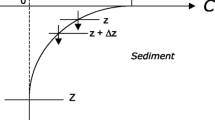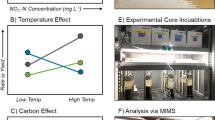Abstract
Wetlands are biogeochemical hotspots that have been identified as important sites for both nitrogen (N) removal from surface waters and greenhouse gas (GHG) production. Floating vegetation (FV) commonly occurs in natural and constructed wetlands, but the effects of such vegetation on denitrification, N retention, and GHG production are unknown. To address this knowledge gap, we used microcosm experiments to examine how FV affects N and GHG dynamics. Denitrification and N retention rates were significantly higher in microcosms with FV (302 μmol N m−2 h−1 and 203 μmol N m−2 h−1, respectively) than in those without (63 μmol N m−2 h−1 and 170 μmol N m−2 h−1, respectively). GHG production rates were not significantly different between the two treatments. Denitrification rates were likely elevated due to decreased dissolved oxygen (DO) in microcosms with FV. The balance of photosynthesis and respiration was more important in affecting DO concentrations than decreased surface gas exchange. The denitrification fraction (N2-N production: N retention) was higher in microcosms with FV (100 %) than those without (33 %) under increased (tripled) N loading. A 5 °C temperature increase resulted in significantly lower denitrification rates in the absence of FV and significantly lowered N2O production with FV, but did not significantly change CH4 production or N retention in either treatment. These results suggest that intentional introduction of FV in constructed wetlands could enhance N removal while leaving GHG production unchanged, an insight that should be further tested via in situ experiments.





Similar content being viewed by others
References
Baron JS, Hall EK, Nolan BT, Finlay JC, Bernhardt ES, Harrison JA, Chan F, Boyer EW (2012) The interactive effects of excess reactive nitrogen and climate change on aquatic ecosystems and water resources of the United States. Biogeochemistry doi: 10.1007/s10533-01209788-y
Beaulieu JJ, Arango CP, Hamilton SK, Tank JL (2008) The production and emission of nitrous oxide from headwater streams in the Midwestern United States. Glob Change Biol 14:878–894
Beaulieu JJ, Tank JL, Hamilton SK et al (2011) Nitrous oxide emission from denitrification in stream and river networks. PNAS 108:214–219
Böhlke JK, Antweiler RC, Harvey JW, Laursen AE, Smith LK, Smith RL, Voytek MA (2009) Milti-scale measurements and modeling of denitrification in streams with varying flow and nitrate concentration in the upper Mississippi River basin, USA. Biogeochemistry 93:117–141
Burgin AJ, Groffman PM, Lewis DN (2010) Factors regulating denitrification in a riparian wetland. Soil Sci Soc Am J 74:1826–1833
Caffery JM, Kemp WM (1992) Influence of the submersed plant, Potamogenton perfoliatus, on nitrogen cycling in estuarine sediments. Limnol Oceanogr 37:1483–1495
Caraco NF, Cole JJ (2002) Contrasting impacts of a native and alien macrophyte on dissolved oxygen in a large river. Ecol Appl 12:1496–1509
Carpenter SR, Caraco NF, Correll DL, Howarth RW, Sharpley AN, Smith VH (1998) Nonpoint pollution of surface waters with phosphorus and nitrogen. Ecol Appl 8:568–599
Cho R, Schroth MH, Zeyer J (2012) Circadian methane oxidation in the root zone of rice plants. Biogeochemistry 111:317–330
Christensen PB, Sørensen J (1986) Temporal variation of denitrification activity in plant-covered, littoral sediment from Lake Hampen, Denmark. Appl Environ Microbiol 51:1174–1179
Deemer BR, Harrison JA, Whitling EW (2011) Microbial dinitrogen and nitrous oxide production in a small eutrophic reservoir: An in situ approach to quantifying hypolimnetic process rates. Limnol Oceanogr 56:1189–1199
Dou J, Liu J, Wang Y, Zhao G (2010) Experimental soil-warming effects on carbon processes of a typical meadow Calamagrostis angustifolia wetland ecosystem in the Sanjiang Plain, northeast China. Acta Agriculturae Scandinavica 60:361–368
Gerhardt S, Brune A, Schink B (2005) Dynamics of redox changes of iron caused by light-dark variations in littoral sediment of a freshwater lake. Biogeochemistry 74:323–339
Goreau TJ, Kaplan WA, Wofsy SC, McElroy MB, Valois FW, Watson SW (1980) Production of NO2 − and N2O by nitrifying bacteria at reduced concentrations of oxygen. Appl Environ Microbiol 40:526–532
Happell JD, Chanton JP, Showers WJ (1995) Methane transfer across the water-air interface in stagnant wooded swamps of Florida: evaluation of mass-transfer coefficients and isotopic fractionation. Limnol Oceanogr 40:290–298
Harrison JA, Matson PA (2003) Patterns and controls of nitrous oxide emissions from waters draining a subtropical agricultural valley. Glob Biogeochem Cycles 17:1080–1092
Harrison JA, Matson PA, Fendorf SE (2005) Effects of a diel oxygen cycle on nitrogen transformations and greenhouse gas emissions in a eutrophied subtropical stream. Aquatic Sci 67:308–315
Hernandez ME, Mitsch WJ (2007) Denitrification in created riverine wetlands: influence of hydrology and season. Ecol Eng 30:78–88
Huang S, Pant HK (2009) Nitrogen transformations in wetlands and marches. J Food Ag Environ 7:946–954
Intergovernmental Panel on Climate Change (IPCC) (2007) in Climate Change 2007: The physical science basis. Contribution of working group I to the fourth assessment report of the intergovernmental panel on climate change, Solomon, S. et al. (eds), Cambridge Univ. Press, New York
Jähne B, Munnich KO, Bosinger R, Dutzi A, Huber W, Libner P (1987) On parameters influencing air–water gas exchange. J Geophys Res 92:1937–1949
Jordan SJ, Stoffer J, Nestlerode JA (2011) Wetlands as sinks for reactive nitrogen at continental and global scales: a meta-analysis. Ecosystems 1:144–155
Kana T, Darkangelo C, Hunk MD, Oldham JB, Bennett GE, Cornwell JC (1994) Membrane inlet mass spectrometer for rapid high-precision determination of N2, O2, and Ar in environmental water samples. Anal Chem 66:4166–4170
Koop-Jakobsen K, Giblin AE (2010) The effect of increased nitrate loading on nitrate reduction via denitrification and DNRA in salt marsh sediments. Limnol Oceanogr 55:789–802
Körner S (1999) Nitrifying and denitrifying bacteria in epiphytic communities of submerged macrophytes in a treated sewage channel. Acta Hydrochim Hydrobiol 27:27–31
Laanbroek HJ (2010) Methane emission from natural wetlands: interplay between emergent macrophytes and soil microbial processes: A mini review. Ann Bot 105:141–153
Laursen AE, Seitzinger SP (2002) Measurement of denitrification in rivers: an integrated, whole reach approach. Hydrobiologia 485:67–81
Laursen AE, Seitzinger SP (2004) Diurnal patterns of denitrification, oxygen consumption and nitrous oxide production in rivers measured at the whole-reach scale. Freshw Biol 49:1448–1458
Liss PS, Slater PG (1974) Flux of gases across the air-sea interface. Nature 247:181–184
Lowrance R, Vellidis G, Hubbard RK (1995) Denitrification in a restored riparian forest wetland. J Environ Qual 24:808–815
Marcarelli AM, Wurtsbaugh WA (2006) Temperature and nutrient supply interact to control nitrogen fixation in oligotrophic streams: an experimental examination. Limnol Oceanogr 51:2278–2289
Mooij WM, Hülsmann S, De Senerpont Domis LN, Nolet BA, Bodelier PLE, Boers PCM, Dionidio Pires LM, Gons HJ, Ibelings BW, Noordhuis R, Portielje R, Wolfstein K, Lammens EHRR (2005) The impact of climate change on lakes in the Netherlands: a review. Aquatic Ecol 39:381–400
Morris PF, Barker WG (1977) Oxygen transport rates through mats of Lemna minor and Wolffia sp. and oxygen tension within and below the mat. Can J Bot 55:1926–1932
Morse JL, Ardón M, Bernhardt ES (2012) Greenhouse gas fluxes in southeastern US coastal plain wetlands under contrasting land uses. Ecol Appl 22:264–280
Nowiki BL (1994) The effect of temperature, oxygen, salinity, and nutrient enrichment on estuarine denitrification rates measured with a modified nitrogen gas flux technique. Estuarine Coastal Shelf Sci 38:137–156
Peralta AL, Matthews JW, Flanagan DN, Kent AD (2012) Environmental factors as dissimilar spatial scales influence plant and microbial communities in restored wetlands. Wetlands 32:1125–1134
Piña-Ochoa E, Álvarez-Cobelas M (2006) Denitrification in aquatic environments: a cross-system analysis. Biogeochemistry 81:111–130
Racchetti E, Bartoli M, Soana E, Longhi D, Christian RR, Pinardi M, Viaroli P (2011) Influence of hydrological connectivity of riverine wetlands on nitrogen removal via denitrification. Biogeochemistry 103:335–354
Ravishankara AR, Daniel JS, Portmann RW (2009) Nitrous oxide (N2O): the dominant ozone-depleting substance emitted in the 21st century. Science 326:123–125
Reddy KR, Patrick WH, Lindau CW (1989) Nitrification-denitrification at the plant root-sediment interface in wetlands. Limnol Oceanogr 34:1004–1013
Rejmánková E (2011) The role of macrophytes in wetland ecosystems. J Ecol Field Biol 34:333–345
Saunders DL, Kalff J (2001) Nitrogen retention in wetlands, lakes and rivers. Hydrobiologia 443:205–212
Scheffe H (1959) The analysis of variance. Wiley, New York, p 477
Schlesinger WH (1997) Biogeochemistry: an analysis of global change. Academic Press, San Diego
Seitzinger S (1994) Linkages between organic matter mineralization and denitrification in eight riparian wetlands. Biogeochemistry 25:19–39
Seitzinger S, Harrison JA, Böhlke JK, Bouwman AF, Lowrance R, Peterson B, Tobias C, Van Drecht G (2006) Denitrification across landscapes and waterscapes: a synthesis. Ecol Appl 16:2064–2090
Silvan N, Tuittila ES, Kitunen V, Vasander H, Laine J (2005) Nitrate uptake by Eriophorum vaginatum controls N2O production in a restored peatland. Soil Biol Biochem 37:1519–1526
Silvennoinen H, Liikanen A, Torssonen J, Stange CF, Martikainen PJ (2008) Denitrification and N2O effluxes in the Bothnian Bay (northern Baltic Sea) river sediments as affected by temperature under different oxygen concentrations. Biogeochemistry 88:63–72
Smialek J, Bouchard V, Lippmann B, Quigley M, Granata T, Martin J, Brown L (2006) Effect of a woody (Salix nigra) and an herbaceous (Juncus effuses) macrophyte species on methane dynamics and denitrification. Wetlands 26:509–517
Song K, Kang H, Zhang L, Mitsch WJ (2012) Seasonal and spatial variations of denitrification and denitrifying bacterial community structure in created riverine wetlands. Ecol Eng 38:130–134
Tall L, Caraco N, Maranger R (2011) Denitrification hot spots: dominant role of invasive macrophyte Trapa natans in removing nitrogen from a tidal river. Ecol Appl 21:3104–3114
Tan Y, Li J, Cheng J, Gu B, Hong J (2013) The sinks of dissolved inorganic nitrogen in surface water of wetland mesocosms. Ecol Eng 52:125–129
Thiere G, Stadmark J, Weisner SEB (2011) Nitrogen retention versus methane emission: environmental benefits and risks of large-scale wetland creation. Ecol Eng 37:6–15
Ullah S, Zinati GM (2006) Denitrification and nitrous oxide emissions from riparian forest soils exposed to prolonged nitrogen runoff. Biogeochemistry 81:253–267
Van Der Nat FWA, Middelberg JJ, Van Meteren D, Wielemakers A (1998) Diel methane emission patterns from Scirpus lacustris and Phragmites australis. Biogeochemistry 41:1–22
Variano EA, HO DT, Engel VC, Schmieder PJ, Reid MC (2009) Flow and mixing dynamics in a patterned wetland: kilometer-scale tracer releases in the Everglades. Water Resour Res 45:W08422. doi:10.1029/2008WR007216
Veraart AJ, de Bruijne WJJ, de Klein JJM, Peeters ETHM, Scheffer M (2011a) Effects of aquatic vegetation type on denitrification. Biogeochemistry 104:267–274
Veraart AJ, de Klein JJM, Scheffer M (2011b) Warming can boost denitrification disproportionately due to altered oxygen dynamics. PLoS ONE 6:e18508
Wanninkhof R (1992) Relationship between wind speed and gas exchange over the ocean. J Geophys Res 97:7373–7382
Weisner SEB, Thiere G (2010) Effects of vegetation state on biodiversity and nitrogen retention in created wetlands: a test of the biodiversity-ecosystem functioning hypothesis. Freshw Biol 55:387–396
Wu H, Zhang J, Wei R, Liang S, Li C, Xie H (2013) Nitrogen transformations and balance in constructed wetlands for slightly polluted river water treatment using different macrophytes. Environ Sci Pollut Res 20:443–451
Yang Y, He Z, Wang Y, Fan J, Liang Z, Stoffella PJ (2013) Dissolved organic matter in relation to nutrients (N and P) and heavy metals in surface runoff water as affected by temporal variation and land uses: a case study from Indian River Area, south Florida, USA. Ag Water Manag 118:38–49
Acknowledgments
This work was funded by a Washington State University Vancouver Mini Grant, a Robert Lane Fellowship, a Greenwell Memorial Scholarship, and the NSF GK-12 Fellowship Program (Grant # DGE-0742561). Thanks to Bridget Deemer, Rebecca Martin, Michelle McCrackin, Natalie Stelsad, Melissa Knudson, Jason Jacobson, Dave Savage, and the WSU machine shop for assistance in this study. We thank Cailin Orr, John Bishop, and two anonymous reviewers for helpful comments on earlier drafts of this manuscript.
Author information
Authors and Affiliations
Corresponding author
Rights and permissions
About this article
Cite this article
Jacobs, A.E., Harrison, J.A. Effects of floating vegetation on denitrification, nitrogen retention, and greenhouse gas production in wetland microcosms. Biogeochemistry 119, 51–66 (2014). https://doi.org/10.1007/s10533-013-9947-9
Received:
Accepted:
Published:
Issue Date:
DOI: https://doi.org/10.1007/s10533-013-9947-9




